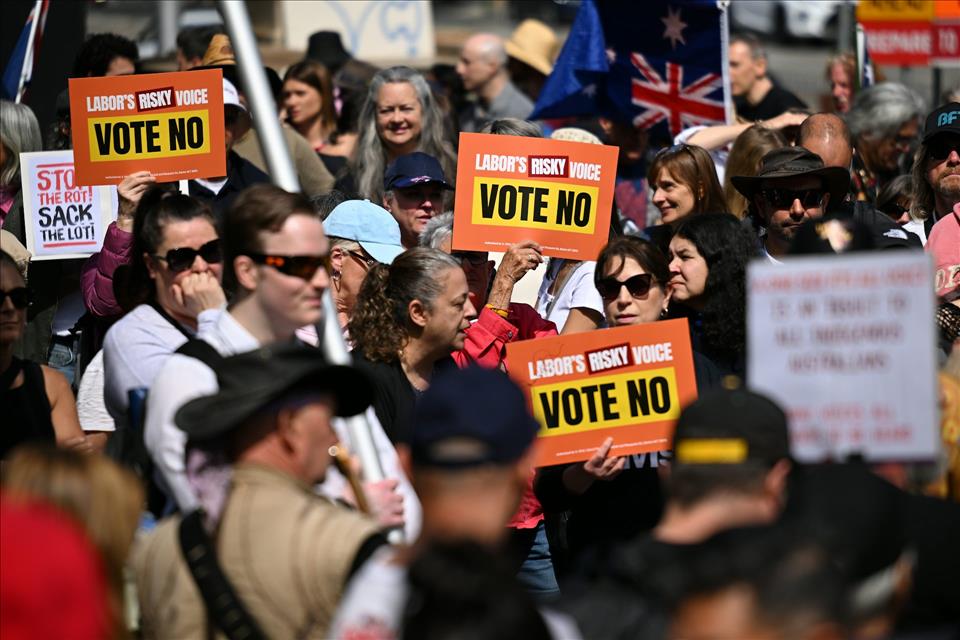
We Found Opposition To The Voice Is Linked To Poorer Indigenous Health. And In Some Regions, The Link Is Striking
It is a picture both striking and urgent.
In research published today we show for the first time that Indigenous Australians living in regions more strongly opposed to the Voice had poorer health.
When we mapped community-level opposition to the Voice to Australians' health, we found Indigenous Australians were more likely than non-Indigenous Australians to report poorer general and mental health. But Indigenous Australians were less likely to access health care. These inequalities were larger in areas with higher opposition to the Voice.
Our results likely reflect underlying negative attitudes towards Indigenous Australians and fewer culturally sensitive options for accessing health care in some regions. Both impact Indigenous Australians' health in numerous ways.
What we did and what we foundWe started with the national map of voting patterns to identify regions with the highest level of opposition to the Voice (defined in this study as regions of Australia where more than 72% of community members voted“no”).
Next, we compared regions with high versus lower levels of opposition to the Voice with Australians' health. We did this using a 2021 national survey , which included information on self-reported general health, mental health, and use of health care in the past year.
Our study showed that compared to Indigenous Australians living in areas with low opposition to the Voice, Indigenous Australians living in communities with the highest opposition to the Voice were more likely to report poor general and mental health, and were less likely to have visited any health care provider in the past year.
We did not see the same disparities for non-Indigenous Australians.
For example, in areas with the greatest support for the Voice, Indigenous and non-Indigenous Australians reported similar levels of poor mental health (16% for both Indigenous and non-Indigenous). Whereas in areas with the strongest opposition to the Voice, 27% of Indigenous Australians reported poor mental health compared with 15% of non-Indigenous Australians.
In areas with the greatest support for the Voice, the proportion of Indigenous Australians who had seen any health care provider was 78%, which was higher than the proportion for non-Indigenous Australians, at 71%. But in areas with strongest opposition to the Voice, the proportion visiting any provider was markedly lower for Indigenous Australians (54%) but not for non-Indigenous Australians (68%).
Altogether, this suggests that despite being in poorer health, Indigenous Australians living in areas with stronger opposition to the Voice are less likely to access health care.
Why is this happening?There are several possible explanations for these results.
A strong possibility, which aligns with recent research , is community-level opposition to the Voice could capture underlying negative attitudes towards Indigenous Australians. So what we're seeing may reflect the impact of such negative attitudes over time on people's health.
This aligns with much international research showing how community-wide stigma and discriminatory environments lead to poorer health among minority and historically marginalised groups. Generally, we see this play out in higher rates of smoking and drinking , and reduced access to health care .
These attitudes could impact Indigenous Australians' experiences of health care. For example, we know previous experiences of racism while accessing health care deters Indigenous people from engaging with mainstream health care . Alternatively, there may not be enough culturally safe health care options in regions with the highest opposition to the Voice.
Indigenous leaders in Australia have continued to share their experiences of racism before, during and after the Voice referendum. While the direct impact of racism is evident in the testimony of these individuals, relatively little attention has been paid to the impact of structural racism at the community level.
But we cannot say from our research what motivated people to vote“no” and a“no” vote cannot be taken as evidence of racism. But whatever the motivation for voting“no”, it is Indigenous Australians' health that is uniquely impacted in these high-opposition regions.
Where from here?Our results suggest that when it comes to future health policy and programs, we need to consider multiple, community-level solutions. In particular, we should pay particular attention to areas where there was greater opposition to the Voice, as these are the areas associated with the worse health and less use of health care.
In these areas, in particular, we need more culturally safe health care , tailored care that is inclusive and free of racism. This is so patients can access relevant and appropriate health services to improve their health .
We also need to look more broadly to change community attitudes about Indigenous Australians if we are to reduce systemic racism , stigma and its impacts on health.
Our results are just a snapshotThe Voice referendum opened our eyes to the fundamental struggle Indigenous Australians face in advancing Indigenous self-determination as the ultimate way to improve life opportunities and health.
But our findings reflect just one moment in time. So we need more research to better understand the systemic nature of the observed health disparities.
Health and social policy needs to account for these systemic issues and ultimately place greater attention on how community-level attitudes can shape the health of Indigenous Australians.

Legal Disclaimer:
MENAFN provides the
information “as is” without warranty of any kind. We do not accept
any responsibility or liability for the accuracy, content, images,
videos, licenses, completeness, legality, or reliability of the information
contained in this article. If you have any complaints or copyright
issues related to this article, kindly contact the provider above.














Comments
No comment